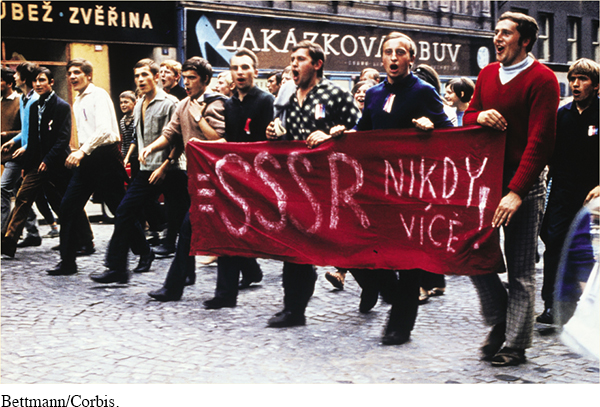The American Promise: Printed Page 846
The American Promise: A Concise History: Printed Page 876
BEYOND AMERICA’S BORDERS
1968: A Year of Protest
To many people living through it, 1968 looked like the start of a worldwide political revolution. A surge of protests against the U.S. war in Vietnam and demands for greater democracy and economic justice jumped over borders and challenged authorities in many countries around the world. Although local grievances ignited much of the unrest, a common feature was the central role played by university students. The protests of 1968 unfolded rapidly, giving rise to excitement and apprehension. From February to December, demonstrations erupted in North and South America, Europe, and Asia. Many demonstrators expressed transnational solidarity by carrying the flag of Vietnam’s National Liberation Front or placards bearing the image of Ernesto “Che” Guevara, a Latin American radical killed by the Bolivian military in 1967. And yet there was little international coordination of events or any shared plan for remaking the world.
One of the first large-
In April and May, violence erupted in the United States. The assassination of Martin Luther King Jr. on April 4 ignited riots in many U.S. cities. Less than a month later, students at Columbia University in New York City seized buildings and shut down the campus, leading to a bloody showdown between police and protesters.
In May, rebellion paralyzed France. It began with students’ complaints about services at a university north of Paris and spread to the Sorbonne in the capital city. Police tear-
Prague, the capital of Communist Czechoslovakia, also stirred in May. A liberal president, Alexander Dubček, pushed for reforms against heavy-
In July, Mexican police attacked marchers carrying posters of Fidel Castro and Che Guevara. When thousands rallied against the violence, police fired into the crowd, killing several students. Violent clashes continued into August and September, as activists protested the Olympic Games, scheduled to open in Mexico City in October. Insisting that the money spent on the Olympics should instead have been used to alleviate the country’s widespread poverty, protesters chanted, “We don’t want Olympic Games; we want revolution.” The upcoming Olympics created pressure for the authorities to clear the city of dissidents. When some 10,000 students assembled for a rally on October 2, jeeps with machine guns arrived. More than 100 protesters were killed, and another several hundred were wounded. The Olympic Games went on as scheduled ten days later.
In the wake of the massacre, protesters staged demonstrations and attacks on Mexican embassies in Latin America and Europe. By December, more episodes of violence against protesters occurred in Spain, Pakistan, and Northern Ireland. In the United States, violence diminished generally, but not in urban ghettos.
By year’s end, a kind of stunned exhaustion set in. The Soviets had shut down the Prague Spring, the student-

Questions for Analysis
Analyze the Evidence: What were some of the specific aims of protesters across the world in 1968?
Ask Historical Questions: What did the global protests of 1968 have in common? In what ways were they different?
Consider the Context: What international events prompted many of the protests?